Novel Starch-Modified NiCrMn-LDH-Based Composite for Photocatalytic Degradation of Reactive Orange 13
Abstract
:1. Introduction
2. Results and Discussion
2.1. XRD Test
2.2. SEM Analysis
2.3. FTIR Test
2.4. DLS and ZETA Potential Analysis
2.5. PZC
2.6. BET Analysis
2.7. TGA and DSC Analysis
2.8. Photocatalytic Degradation of Reactive Orange 13
2.8.1. Effect of Photocatalyst Dose
2.8.2. Effect of Initial Dye Concentration
2.8.3. Effect of pH
2.8.4. Effect of Inorganic Salts
2.8.5. Effect of Hydrogen Peroxide
2.8.6. Effect of Sacrificial Reagents
2.9. Kinetics Study
2.10. Mechanism of Photodegradation
3. Experimental
3.1. Materials and Method
3.2. Preparation of Starch Modified NiCrMn-LDH (S/NiCrMn-LDH) Composite
4. Conclusions
Supplementary Materials
Author Contributions
Funding
Data Availability Statement
Acknowledgments
Conflicts of Interest
References
- Hosny, N.M.; Gomaa, I.; Elmahgary, M.G. Adsorption of polluted dyes from water by transition metal oxides: A review. Appl. Surf. Sci. Adv. 2023, 15, 395. [Google Scholar] [CrossRef]
- Rehman, M.U.; Taj, M.B.; Carabineiro, S.A. Biogenic adsorbents for removal of drugs and dyes: A comprehensive review on properties, modification and applications. Chemosphere 2023, 338, 139477. [Google Scholar] [CrossRef]
- Jaleh, B.; Mousavi, S.S.; Sajjadi, M.; Eslamipanah, M.; Maryaki, M.J.; Orooji, Y.; Varma, R.S. Synthesis of bentonite/Ag nano-composite by laser ablation in air and its application in remediation. Chemosphere 2023, 315, 137668. [Google Scholar] [CrossRef] [PubMed]
- Keyikoğlu, R.; Khataee, A.; Orooji, Y.; Kobya, M. Synergistic effect of Fe and Co metals for the enhanced activation of hydrogen peroxide in the heterogeneous electro-Fenton process by Co-doped ZnFe layered double hydroxide. J. Environ. Chem. Eng. 2022, 10, 108875. [Google Scholar] [CrossRef]
- Chaudhary, M.; Jain, N.; Barman, L.; Bhowmick, G. Design and principles of adsorbent-based reactors for modular wastewater treatment. In Modular Treatment Approach for Drinking Water and Wastewater; Elsevier: Amsterdam, The Netherlands, 2022; pp. 129–148. [Google Scholar]
- Grover, A.; Mohiuddin, I.; Malik, A.K.; Aulakh, J.S.; Vikrant, K.; Kim, K.-H.; Brown, R. Magnesium/aluminum layered double hydroxides intercalated with starch for effective adsorptive removal of anionic dyes. J. Hazard. Mater. 2021, 424, 127454. [Google Scholar] [CrossRef]
- Stawiński, W.; Węgrzyn, A.; Freitas, O.; Chmielarz, L.; Mordarski, G.; Figueiredo, S. Simultaneous removal of dyes and metal cations using an acid, acid-base and base modified vermiculite as a sustainable and recyclable adsorbent. Sci. Total. Environ. 2017, 576, 398–408. [Google Scholar] [CrossRef] [PubMed]
- Al-Tohamy, R.; Ali, S.S.; Li, F.; Okasha, K.M.; Mahmoud, Y.A.-G.; Elsamahy, T.; Jiao, H.; Fu, Y.; Sun, J. A critical review on the treatment of dye-containing wastewater: Ecotoxicological and health concerns of textile dyes and possible remediation approaches for environmental safety. Ecotoxicol. Environ. Saf. 2022, 231, 113160. [Google Scholar] [CrossRef]
- Khan, S.; Naushad, M.; Govarthanan, M.; Iqbal, J.; Alfadul, S.M. Emerging contaminants of high concern for the environment: Current trends and future research. Environ. Res. 2022, 207, 112609. [Google Scholar] [CrossRef] [PubMed]
- Usman, M.; Taj, M.B.; Carabineiro, S.A.C. Gum-based nanocomposites for the removal of metals and dyes from waste water. Environ. Sci. Pollut. Res. 2023, 30, 102027–102046. [Google Scholar] [CrossRef]
- Samsami, S.; Mohamadizaniani, M.; Sarrafzadeh, M.-H.; Rene, E.R.; Firoozbahr, M. Recent advances in the treatment of dye-containing wastewater from textile industries: Overview and perspectives. Process. Saf. Environ. Prot. 2020, 143, 138–163. [Google Scholar] [CrossRef]
- Ismail, M.; Akhtar, K.; Khan, M.I.; Kamal, T.; Khan, M.A.; Asiri, A.M.; Seo, J.; Khan, S.B. Pollution, Toxicity and Carcinogenicity of Organic Dyes and their Catalytic Bio-Remediation. Curr. Pharm. Des. 2019, 25, 3645–3663. [Google Scholar] [CrossRef] [PubMed]
- Dhruv Patel, D.; Bhatt, S.J.B.; Reviews, G.E. Environmental pollution, toxicity profile, and physico-chemical and biotechno-logical approaches for treatment of textile wastewater. Biotechnol. Genet. Eng. Rev. 2022, 38, 33–86. [Google Scholar] [CrossRef] [PubMed]
- Lellis, B.; Fávaro-Polonio, C.Z.; Pamphile, J.A.; Polonio, J.C. Effects of textile dyes on health and the environment and bioremediation potential of living organisms. Biotechnol. Res. Innov. 2019, 3, 275–290. [Google Scholar] [CrossRef]
- Demirkol, O.; Zhang, X.; Ercal, N.J. Oxidative effects of Tartrazine (CAS No. 1934-21-0) and New Coccin (CAS No. 2611-82-7) azo dyes on CHO cells. J. Verbraucherschutz Leb. 2012, 7, 229–236. [Google Scholar] [CrossRef]
- Fatima, M.; Farooq, R.; Lindström, R.W.; Saeed, M. A review on biocatalytic decomposition of azo dyes and electrons re-covery. J. Mol. Liq. 2017, 246, 275–281. [Google Scholar] [CrossRef]
- Gurav, R.; Bhatia, S.K.; Choi, T.-R.; Choi, Y.-K.; Kim, H.J.; Song, H.-S.; Lee, S.M.; Park, S.L.; Lee, H.S.; Koh, J. Application of macroalgal biomass derived biochar and bioelectrochemical system with Shewanella for the adsorptive removal and bio-degradation of toxic azo dye. Chemosphere 2021, 264, 128539. [Google Scholar] [CrossRef] [PubMed]
- El-Rahim, W.M.A.; Moawad, H.; Azeiz, A.Z.A.; Sadowsky, M. Biodegradation of azo dyes by bacterial or fungal consortium and identification of the biodegradation products. Egypt. J. Aquat. Res. 2021, 47, 269–276. [Google Scholar] [CrossRef]
- Azin, E.; Moghimi, H. Efficient mycosorption of anionic azo dyes by Mucor circinelloides: Surface functional groups and removal mechanism study. J. Environ. Chem. Eng. 2018, 6, 4114–4123. [Google Scholar] [CrossRef]
- Shi, Y.; Yang, Z.; Xing, L.; Zhang, X.; Li, X.; Zhang, D. Recent advances in the biodegradation of azo dyes. World J. Microbiol. Biotechnol. 2021, 37, 1–18. [Google Scholar] [CrossRef]
- Tayebi, H.-A.; Ghanei, M.; Aghajani, K.; Zohrevandi, M. Modeling of reactive orange 16 dye removal from aqueous media by mesoporous silica/crosslinked polymer hybrid using RBF, MLP and GMDH neural network models. J. Mol. Struct. 2019, 1178, 514–523. [Google Scholar] [CrossRef]
- Javaid, R.; Qazi, U.Y. Catalytic oxidation process for the degradation of synthetic dyes: An overview. Int. J. Environ. Res. Public Health 2019, 16, 2066. [Google Scholar] [CrossRef] [PubMed]
- Mishra, S.; Maiti, A. Applicability of enzymes produced from different biotic species for biodegradation of textile dyes. Clean Technol. Environ. Policy 2019, 21, 763–781. [Google Scholar] [CrossRef]
- Donkadokula, N.Y.; Kola, A.K.; Naz, I.; Saroj, D. A review on advanced physico-chemical and biological textile dye wastewater treatment techniques. Rev. Environ. Sci. Bio/Technol. 2020, 19, 543–560. [Google Scholar] [CrossRef]
- Eteba, A.; Bassyouni, M.; Saleh, M. Utilization of chemically modified coal fly ash as cost-effective adsorbent for removal of hazardous organic wastes. Int. J. Environ. Sci. Technol. 2022, 20, 7589–7602. [Google Scholar] [CrossRef]
- Zarrini, K.; Rahimi, A.A.; Alihosseini, F.; Fashandi, H. Highly efficient dye adsorbent based on polyaniline-coated nylon-6 nanofibers. J. Clean. Prod. 2017, 142, 3645–3654. [Google Scholar] [CrossRef]
- Ponraj, M.; Gokila, K.; Zambare, V. Bacterial decolorization of textile dye-Orange 3R. Int. J. Adv. Biotechnol. Res. 2011, 2, 168–177. [Google Scholar]
- Ihsanullah, I.; Jamal, A.; Ilyas, M.; Zubair, M.; Khan, G.; Atieh, M.A. Bioremediation of dyes: Current status and prospects. J. Water Process. Eng. 2020, 38, 101680. [Google Scholar] [CrossRef]
- Kekes, T.; Tzia, C.; Kolliopoulos, G. Drinking and Natural Mineral Water: Treatment and Quality–Safety Assurance. Water 2023, 15, 2325. [Google Scholar] [CrossRef]
- Aziz, K.H.H.; Mustafa, F.S.; Omer, K.M.; Hama, S.; Hamarawf, R.F.; Rahman, K.O. Heavy metal pollution in the aquatic environment: Efficient and low-cost removal approaches to eliminate their toxicity: A review. RSC Adv. 2023, 13, 17595–17610. [Google Scholar] [CrossRef]
- Intisar, A.; Ramzan, A.; Hafeez, S.; Hussain, N.; Irfan, M.; Shakeel, N.; Gill, K.A.; Iqbal, A.; Janczarek, M.; Jesionowski, T. Adsorptive and photocatalytic degradation potential of porous polymeric materials for removal of pesticides, pharmaceuticals, and dyes-based emerging contaminants from water. Chemosphere 2023, 336, 139203. [Google Scholar] [CrossRef]
- Tahir, M.S.; Sagir, M.; Tahir, M.B. Wastewater Treatment Methods. In Advances in Water and Wastewater Treatment Technology; Springer: Berlin/Heidelberg, Germany, 2023; pp. 35–52. [Google Scholar]
- Hussain, Z.; Chang, N.; Sun, J.; Xiang, S.; Ayaz, T.; Zhang, H.; Wang, H. Modification of coal fly ash and its use as low-cost adsorbent for the removal of directive, acid and reactive dyes. J. Hazard. Mater. 2022, 422, 126778. [Google Scholar] [CrossRef] [PubMed]
- Saleh, T.A.; Mustaqeem, M.; Khaled, M. Water treatment technologies in removing heavy metal ions from wastewater: A review. Environ. Nanotechnol. Monit. Manag. 2021, 17, 100617. [Google Scholar] [CrossRef]
- Li, P.; Li, Y.-X.; Wu, Y.-Z.; Xu, Z.-L.; Zhang, H.-Z.; Gao, P.; Xu, S.-J. Thin-film nanocomposite NF membrane with GO on macroporous hollow fiber ceramic substrate for efficient heavy metals removal. Environ. Res. 2021, 197, 111040. [Google Scholar] [CrossRef] [PubMed]
- Alansi, A.M.; Qahtan, T.F.; Saleh, T.A. Solar-Driven Fixation of Bismuth Oxyhalides on Reduced Graphene Oxide for Efficient Sunlight-Responsive Immobilized Photocatalytic Systems. Adv. Mater. Interfaces 2020, 8. [Google Scholar] [CrossRef]
- Shah, P.D.; Dave, S.R.; Rao, M. Enzymatic degradation of textile dye Reactive Orange 13 by newly isolated bacterial strain Alcaligenes faecalis PMS-1. Int. Biodeterior. Biodegrad. 2012, 69, 41–50. [Google Scholar] [CrossRef]
- Swain, S.K.; Barik, S.; Pradhan, G.C.; Behera, L. Delamination of Mg-Al Layered Double Hydroxide on Starch: Change in Structural and Thermal Properties. Polym. Technol. Eng. 2018, 57, 1585–1591. [Google Scholar] [CrossRef]
- Bansal, M.; Pal, B. Starch modified NiFe layered double hydroxide composites for better adsorption and photocatalytic removal of reactive dye and piroxicam-20 drug. Environ. Sci. Pollut. Res. 2023, 30, 73825–73848. [Google Scholar] [CrossRef] [PubMed]
- Falua, K.J.; Pokharel, A.; Babaei-Ghazvini, A.; Ai, Y.; Acharya, B. Valorization of Starch to Biobased Materials: A Review. Polymers 2022, 14, 2215. [Google Scholar] [CrossRef]
- Pradhan, S.; Brooks, A.; Yadavalli, V. Nature-derived materials for the fabrication of functional biodevices. Mater. Today Bio 2020, 7, 100065. [Google Scholar] [CrossRef]
- Tabasum, S.; Younas, M.; Zaeem, M.A.; Majeed, I.; Majeed, M.; Noreen, A.; Iqbal, M.N.; Zia, K.M. A review on blending of corn starch with natural and synthetic polymers, and inorganic nanoparticles with mathematical modeling. Int. J. Biol. Macromol. 2018, 122, 969–996. [Google Scholar] [CrossRef]
- Teixeira, M.A.; Antunes, J.C.; Seabra, C.L.; Fertuzinhos, A.; Tohidi, S.D.; Reis, S.; Amorim, M.T.P.; Ferreira, D.P. Antibacterial and hemostatic capacities of cellulose nanocrystalline-reinforced poly (vinyl alcohol) electrospun mats doped with Tiger 17 and pexiganan peptides for prospective wound healing applications. Biomater. Adv. 2022, 137, 212830. [Google Scholar] [CrossRef]
- Barik, S.; Badamali, S.K. Layer double hydroxide reinforced polymer bionanocomposites for packaging applications. In Bionanocomposites for Packaging Applications; Springer: Cham, Switzerland, 2018; pp. 269–290. [Google Scholar]
- Abdallah, I.A.; Hammad, S.F.; Bedair, A.; Abdelhameed, R.M.; Locatelli, M.; Mansour, F.R. Applications of layered double hydroxides in sample preparation: A review. Microchem. J. 2023, 192. [Google Scholar] [CrossRef]
- Kameliya, J.; Verma, A.; Dutta, P.; Arora, C.; Vyas, S.; Varma, R.S. Layered Double Hydroxide Materials: A Review on Their Preparation, Characterization, and Applications. Inorganics 2023, 11, 121. [Google Scholar] [CrossRef]
- Sharma, A.; Kumari, S.; Sharma, S.; Singh, T.; Kumar, S.; Thakur, A.; Bhatia, S.K.; Sharma, A.K. Layered Double Hydroxides: An insight into the role of Hydrotalcite-type Anionic Clays in Energy and Environmental applications with Current Progress and Recent Prospects. Mater. Today Sustain. 2023, 22, 100399. [Google Scholar] [CrossRef]
- Huang, Y.; Liu, C.; Rad, S.; He, H.; Qin, L. A Comprehensive Review of Layered Double Hydroxide-Based Carbon Composites as an Environmental Multifunctional Material for Wastewater Treatment. Processes 2022, 10, 617. [Google Scholar] [CrossRef]
- Lu, Y.; Jiang, B.; Fang, L.; Ling, F.; Gao, J.; Wu, F.; Zhang, X. High performance NiFe layered double hydroxide for methyl orange dye and Cr(VI) adsorption. Chemosphere 2016, 152, 415–422. [Google Scholar] [CrossRef]
- Zubair, M.; Jarrah, N.; Khalid, A.; Manzar, M.S.; Kazeem, T.S.; Al-Harthi, M.A. Starch-NiFe-layered double hydroxide composites: Efficient removal of methyl orange from aqueous phase. J. Mol. Liq. 2018, 249, 254–264. [Google Scholar] [CrossRef]
- Lei, C.; Pi, M.; Kuang, P.; Guo, Y.; Zhang, F. Organic dye removal from aqueous solutions by hierarchical calcined Ni-Fe layered double hydroxide: Isotherm, kinetic and mechanism studies. J. Colloid Interface Sci. 2017, 496, 158–166. [Google Scholar] [CrossRef]
- Liu, M.; Chen, Q.; Lu, K.; Huang, W.; Lü, Z.; Zhou, C.; Yu, S.; Gao, C. High efficient removal of dyes from aqueous solution through nanofiltration using diethanolamine-modified polyamide thin-film composite membrane. Sep. Purif. Technol. 2017, 173, 135–143. [Google Scholar] [CrossRef]
- Shan, R.-R.; Yan, L.-G.; Yang, Y.-M.; Yang, K.; Yu, S.-J.; Yu, H.-Q.; Zhu, B.-C.; Du, B. Highly efficient removal of three red dyes by adsorption onto Mg–Al-layered double hydroxide. J. Ind. Eng. Chem. 2015, 21, 561–568. [Google Scholar] [CrossRef]
- Yang, Z.; Wang, F.; Zhang, C.; Zeng, G.; Tan, X.; Yu, Z.; Zhong, Y.; Wang, H.; Cui, F. Utilization of LDH-based materials as potential adsorbents and photocatalysts for the decontamination of dyes wastewater: A review. RSC Adv. 2016, 6, 79415–79436. [Google Scholar] [CrossRef]
- Liu, C.; Mao, S.; Shi, M.; Wang, F.; Xia, M.; Chen, Q.; Ju, X. Peroxymonosulfate activation through 2D/2D Z-scheme CoAl-LDH/BiOBr photocatalyst under visible light for ciprofloxacin degradation. J. Hazard. Mater. 2021, 420, 126613. [Google Scholar] [CrossRef]
- Liu, G.; Zhang, X.; Liu, H.; He, Z.; Show, P.L.; Vasseghian, Y.; Wang, C. Biochar/layered double hydroxides composites as catalysts for treatment of organic wastewater by advanced oxidation processes: A review. Environ. Res. 2023, 234, 116534. [Google Scholar] [CrossRef]
- Khan, M.A.; Fattah-Alhosseini, A.; Kaseem, M. Recent advances in the design and surface modification of titanium-based LDH for photocatalytic applications. Inorg. Chem. Commun. 2023, 153, 110739. [Google Scholar] [CrossRef]
- Ebrahimpour, Z.; Pliekhova, O.; Cabrera, H.; Abdelhamid, M.; Korte, D.; Gadedjisso-Tossou, K.S.; Niemela, J.; Stangar, U.L.; Franko, M. Photodegradation mechanisms of reactive blue 19 dye under UV and simulated solar light irradiation. Spectrochim. Acta Part A Mol. Biomol. Spectrosc. 2021, 252, 119481. [Google Scholar] [CrossRef]
- Zubair, M.; Jarrah, N.; Manzar, M.S.; Al-Harthi, M.; Daud, M.; Mu’azu, N.D.; Haladu, S.A. Adsorption of eriochrome black T from aqueous phase on MgAl-, CoAl- and NiFe- calcined layered double hydroxides: Kinetic, equilibrium and thermodynamic studies. J. Mol. Liq. 2017, 230, 344–352. [Google Scholar] [CrossRef]
- Chang, P.R.; Zheng, P.; Liu, B.; Anderson, D.P.; Yu, J.; Ma, X. Characterization of magnetic soluble starch-functionalized carbon nanotubes and its application for the adsorption of the dyes. J. Hazard. Mater. 2011, 186, 2144–2150. [Google Scholar] [CrossRef]
- Mujtaba, G.; Ullah, A.; Khattak, D.; Shah, M.U.H.; Daud, M.; Ahmad, S.; Hai, A.; Ahmed, F.; Alshahrani, T.; Banat, F. Simultaneous adsorption of methylene blue and amoxicillin by starch-impregnated MgAl layered double hydroxide: Parametric optimization, isothermal studies and thermo-kinetic analysis. Environ. Res. 2023, 235, 116610. [Google Scholar] [CrossRef]
- Mu’azu, N.D.; Haladu, S.A.; Jarrah, N.; Zubair, M.; Essa, M.H.; Ali, S.A. Polyaspartate extraction of cadmium ions from contaminated soil: Evaluation and optimization using central composite design. J. Hazard. Mater. 2018, 342, 58–68. [Google Scholar] [CrossRef]
- Popa, M.I.; Alexandrica, M.C.; Silion, M.; Hritcu, D. Layered double hydroxides as adsorbents for anionic dye removal from aqueous solutions. Environ. Eng. Manag. J. 2015, 14, 381–388. [Google Scholar] [CrossRef]
- Samuei, S.; Fakkar, J.; Rezvani, Z.; Shomali, A.; Habibi, B. Synthesis and characterization of graphene quantum dots/CoNiAl-layered double-hydroxide nanocomposite: Application as a glucose sensor. Anal. Biochem. 2017, 521, 31–39. [Google Scholar] [CrossRef] [PubMed]
- Silion, M.; Hritcu, D.; Popa, M. Preparation and characterization of ketoprofen-layered double hydroxide compounds. J. Optoelectron. Adv. Mater. Interfaces 2010, 12, 2150–2156. [Google Scholar]
- Taj, M.B.; Alkahtani, M.D.F.; Raheel, A.; Shabbir, S.; Fatima, R.; Aroob, S.; Yahya, R.; Alelwani, W.; Alahmadi, N.; Abualnaja, M.; et al. Bioconjugate synthesis, phytochemical analysis, and optical activity of NiFe2O4 nanoparticles for the removal of ciprofloxacin and Congo red from water. Sci. Rep. 2021, 11, 5439. [Google Scholar] [CrossRef] [PubMed]
- Biswas, S.; Siddiqi, H.; Meikap, B.C.; Sen, T.K.; Khiadani, M. Preparation and Characterization of Raw and Inorganic Acid-Activated Pine Cone Biochar and Its Application in the Removal of Aqueous-Phase Pb2+ Metal Ions by Adsorption. Water Air Soil Pollut. 2019, 231, 3. [Google Scholar] [CrossRef]
- Kotp, Y.H. Fabrication of cerium titanate cellulose fiber nanocomposite materials for the removal of methyl orange and methylene blue from polluted water by photocatalytic degradation. Environ. Sci. Pollut. Res. 2022, 29, 81583–81608. [Google Scholar] [CrossRef] [PubMed]
- Fang, K.; Li, K.; Yang, T.; Li, J.; He, W. Starch-based magnetic nanocomposite as an efficient absorbent for anticancer drug removal from aqueous solution. Int. J. Biol. Macromol. 2021, 184, 509–521. [Google Scholar] [CrossRef] [PubMed]
- Das, D.; Jha, S.; Kumar, K.J. Effect of carboxymethylation on physicochemical and release characteristics of Indian Palo starch. Int. J. Biol. Macromol. 2015, 77, 181–187. [Google Scholar] [CrossRef] [PubMed]
- Fernandes, S.C.; Freire, C.S.; Silvestre, A.J.; Neto, C.P.; Gandini, A.; Berglund, L.A.; Salmén, L. Transparent chitosan films reinforced with a high content of nanofibrillated cellulose. Carbohydr. Polym. 2010, 81, 394–401. [Google Scholar] [CrossRef]
- Valera-Zaragoza, M.; Huerta-Heredia, A.A.; Peña-Rico, M.A.; Juarez-Arellano, E.A.; Navarro-Mtz, A.K.; Ramírez-Vargas, E.; Sánchez-Valdes, S. Morphological, structural and cytotoxic behavior of starch/silver nanocomposites with synthesized silver nanoparticles using Stevia rebaudiana extracts. Polym. Bull. 2020, 78, 1683–1701. [Google Scholar] [CrossRef]
- Bibi, A.; Sadiq-Ur-Rehman, S.-U.; Akhtar, T.; Shahzad, M.I. Effective removal of carcinogenic dye from aqueous solution by using alginate-based nanocomposites. Desalination Water Treat. 2020, 208, 386–398. [Google Scholar] [CrossRef]
- Liu, X.; Zhang, T.; Xu, D.; Zhang, L. Microwave-Assisted Catalytic Degradation of Crystal Violet with Barium Ferrite Nanomaterial. Ind. Eng. Chem. Res. 2016, 55, 11869–11877. [Google Scholar] [CrossRef]
- Battin, E.E.; Brumaghim, J.L. Antioxidant activity of sulfur and selenium: A review of reactive oxygen species scavenging, glutathione peroxidase, and metal-binding antioxidant mechanisms. Cell Biochem. Biophys. 2009, 55, 1–23. [Google Scholar] [CrossRef]
- Rojas-Carbonell, S.; Artyushkova, K.; Serov, A.; Santoro, C.; Matanovic, I.; Atanassov, P. Effect of pH on the Activity of Platinum Group Metal-Free Catalysts in Oxygen Reduction Reaction. ACS Catal. 2018, 8, 3041–3053. [Google Scholar] [CrossRef]
- Faria, P.; Órfão, J.; Pereira, M. Adsorption of anionic and cationic dyes on activated carbons with different surface chemistries. Water Res. 2004, 38, 2043–2052. [Google Scholar] [CrossRef]
- Ilyas, A.; Rafiq, K.; Abid, M.Z.; Rauf, A.; Hussain, E. Growth of villi-microstructured bismuth vanadate (Vm-BiVO4) for photocatalytic degradation of crystal violet dye. RSC Adv. 2023, 13, 2379–2391. [Google Scholar]
- Wang, M.; Shen, S.; Li, L.; Tang, Z.; Yang, J. Effects of sacrificial reagents on photocatalytic hydrogen evolution over different photocatalysts. J. Mater. Sci. 2017, 52, 5155–5164. [Google Scholar] [CrossRef]
- Abunowara, M.; Bustam, M.A.; Sufian, S.; Babar, M.; Eldemerdash, U.; Mukhtar, A.; Ullah, S.; Assiri, M.A.; Al-Sehemi, A.G.; Lam, S.S. High pressure CO2 adsorption onto Malaysian Mukah-Balingian coals: Adsorption isotherms, thermodynamic and kinetic investigations. Environ. Res. 2023, 218, 114905. [Google Scholar] [CrossRef] [PubMed]
- Hao, L.; Luan, J. The Fabrication and Property Characterization of a Ho2YSbO7/Bi2MoO6 Heterojunction Photocatalyst and the Application of the Photodegradation of Diuron under Visible Light Irradiation. Int. J. Mol. Sci. 2024, 25, 4418. [Google Scholar] [CrossRef] [PubMed]

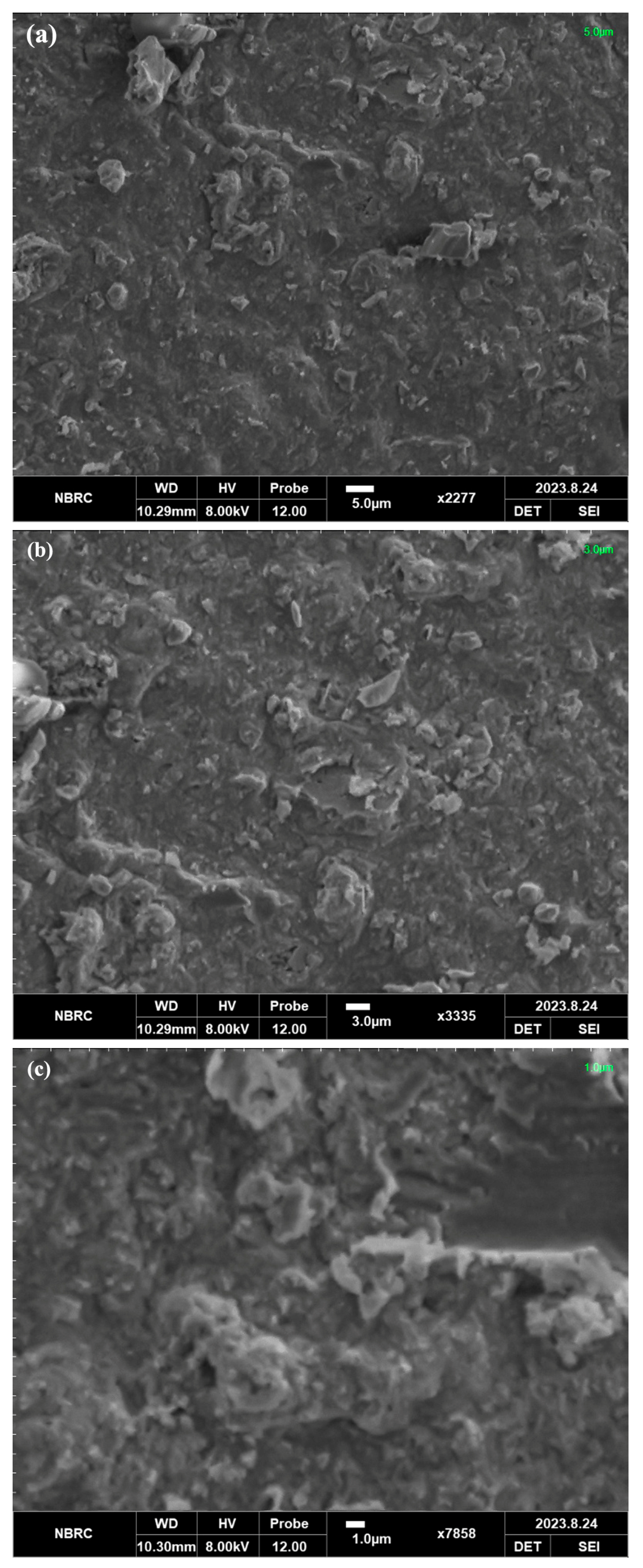

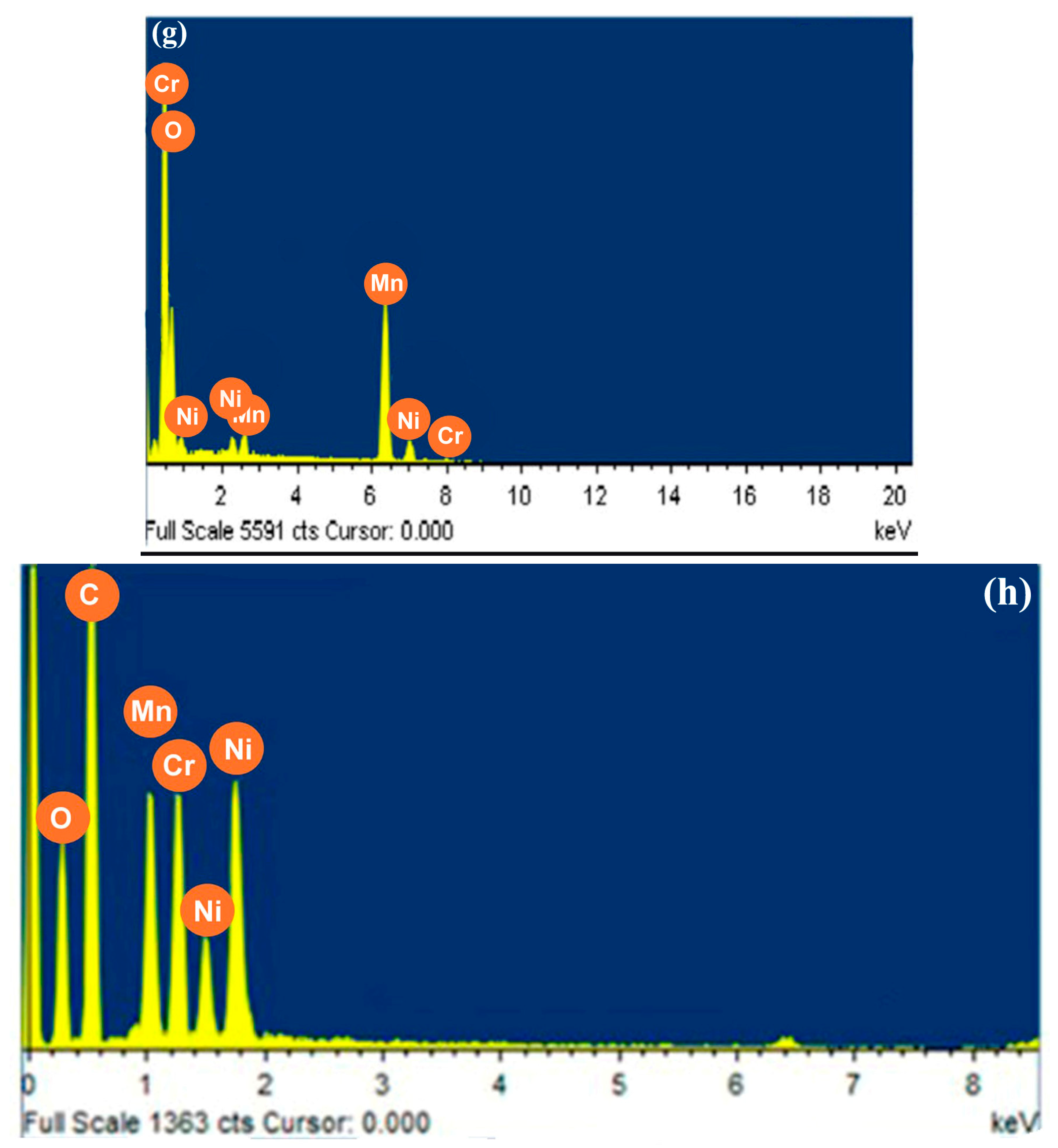
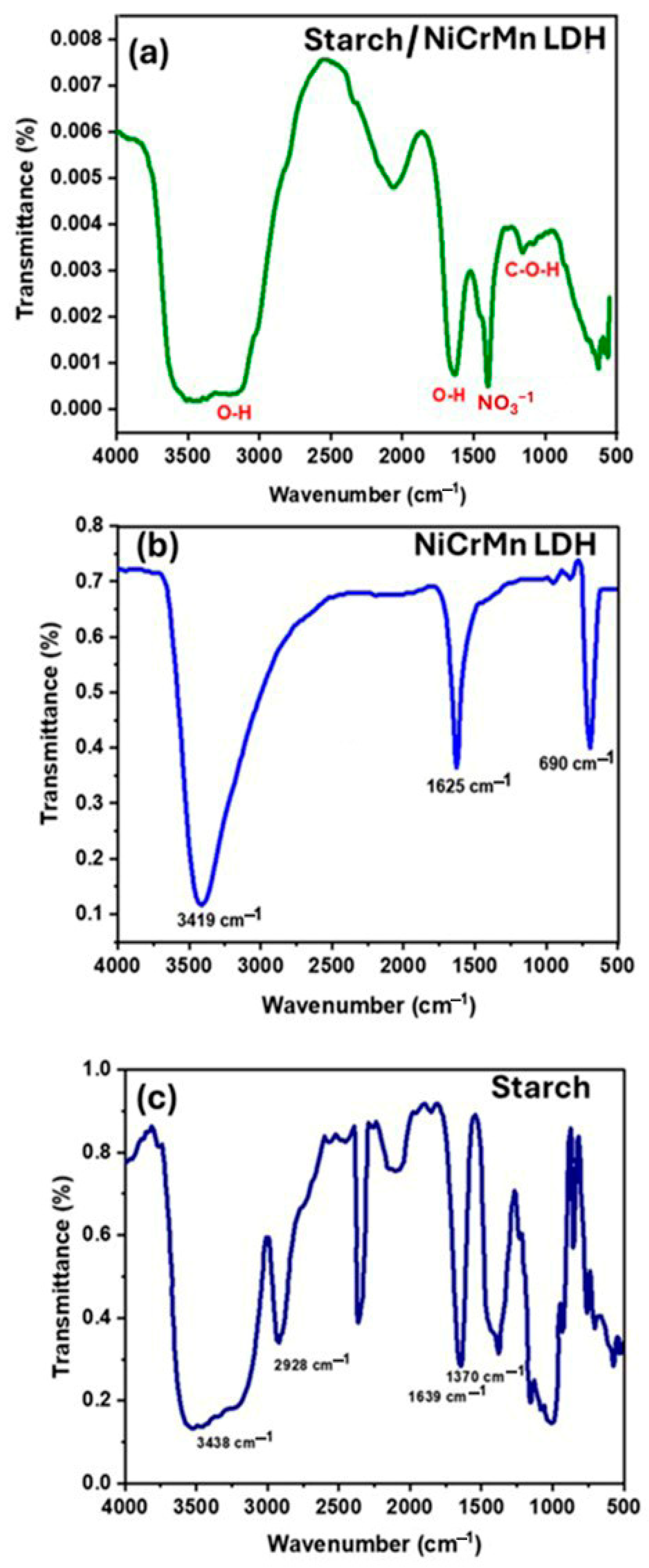

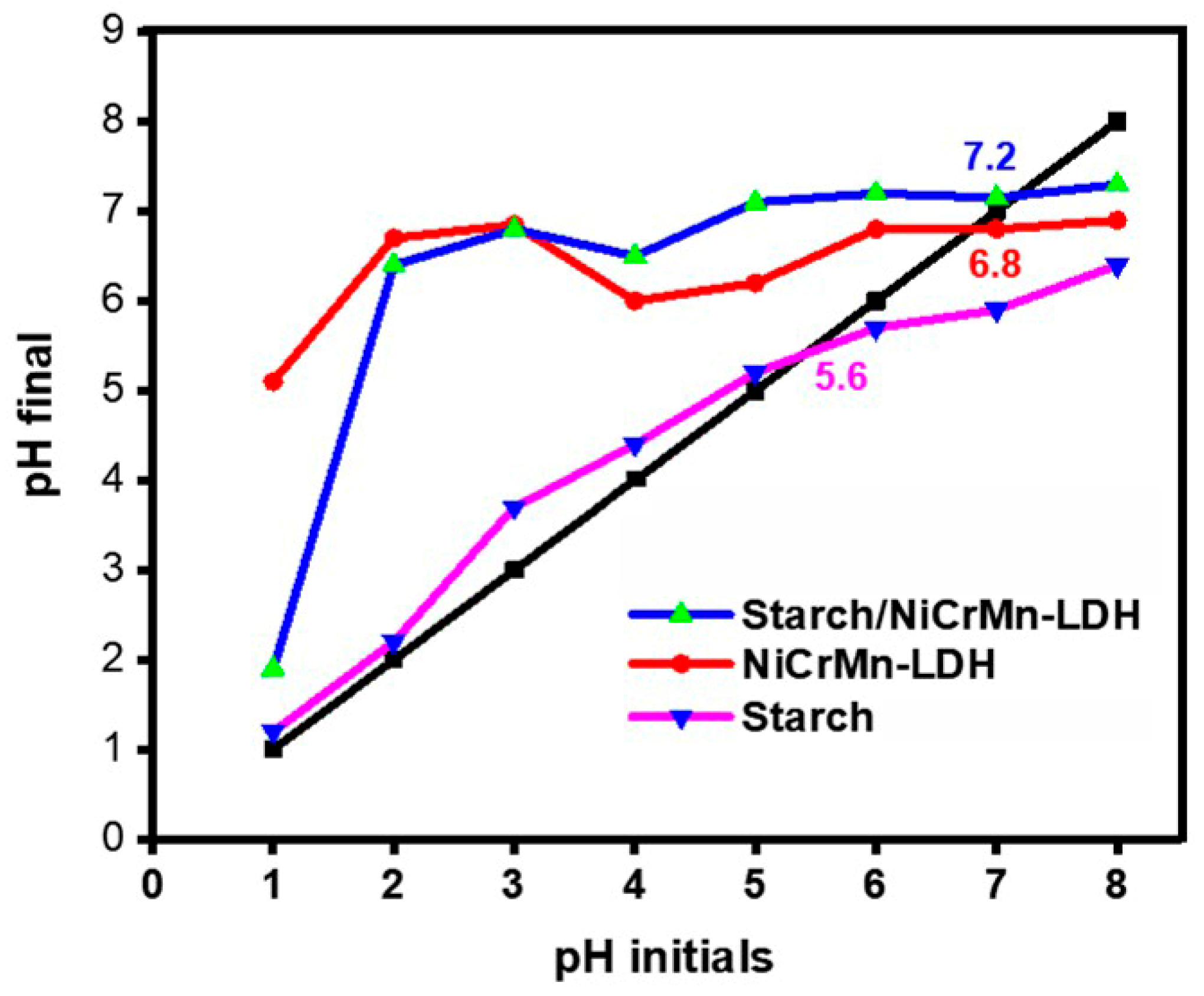
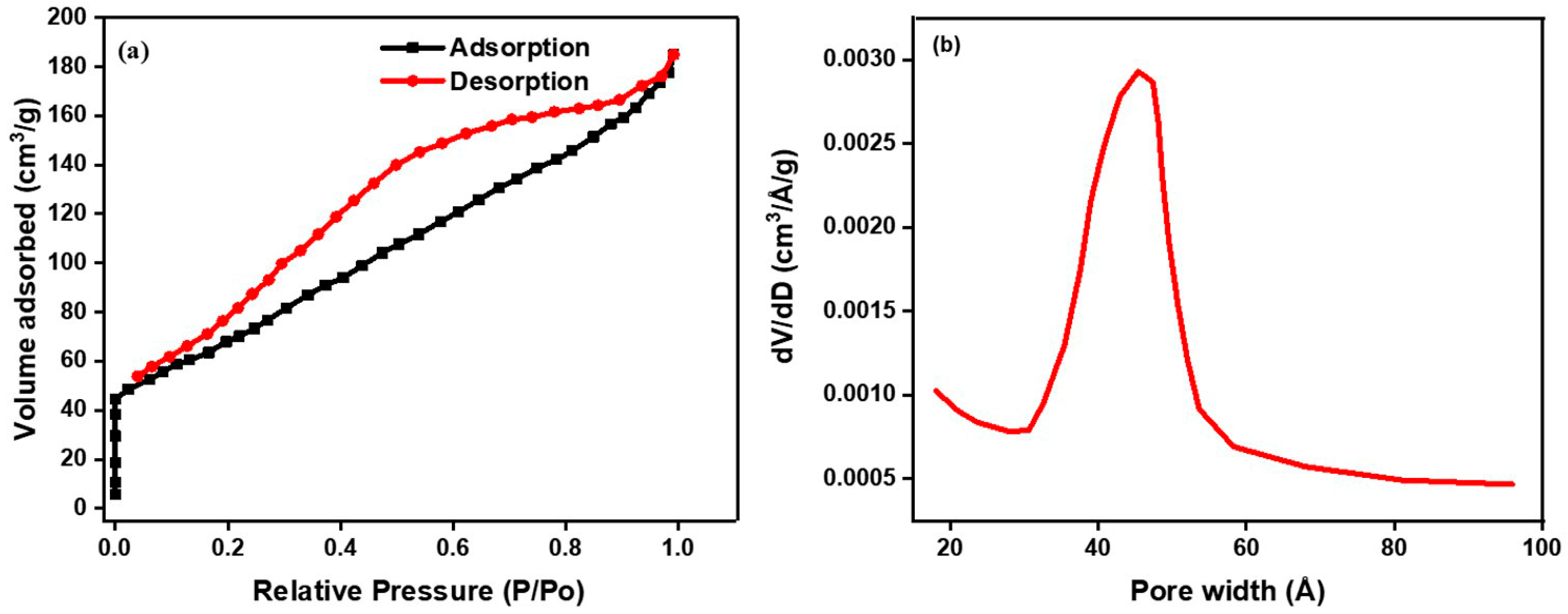



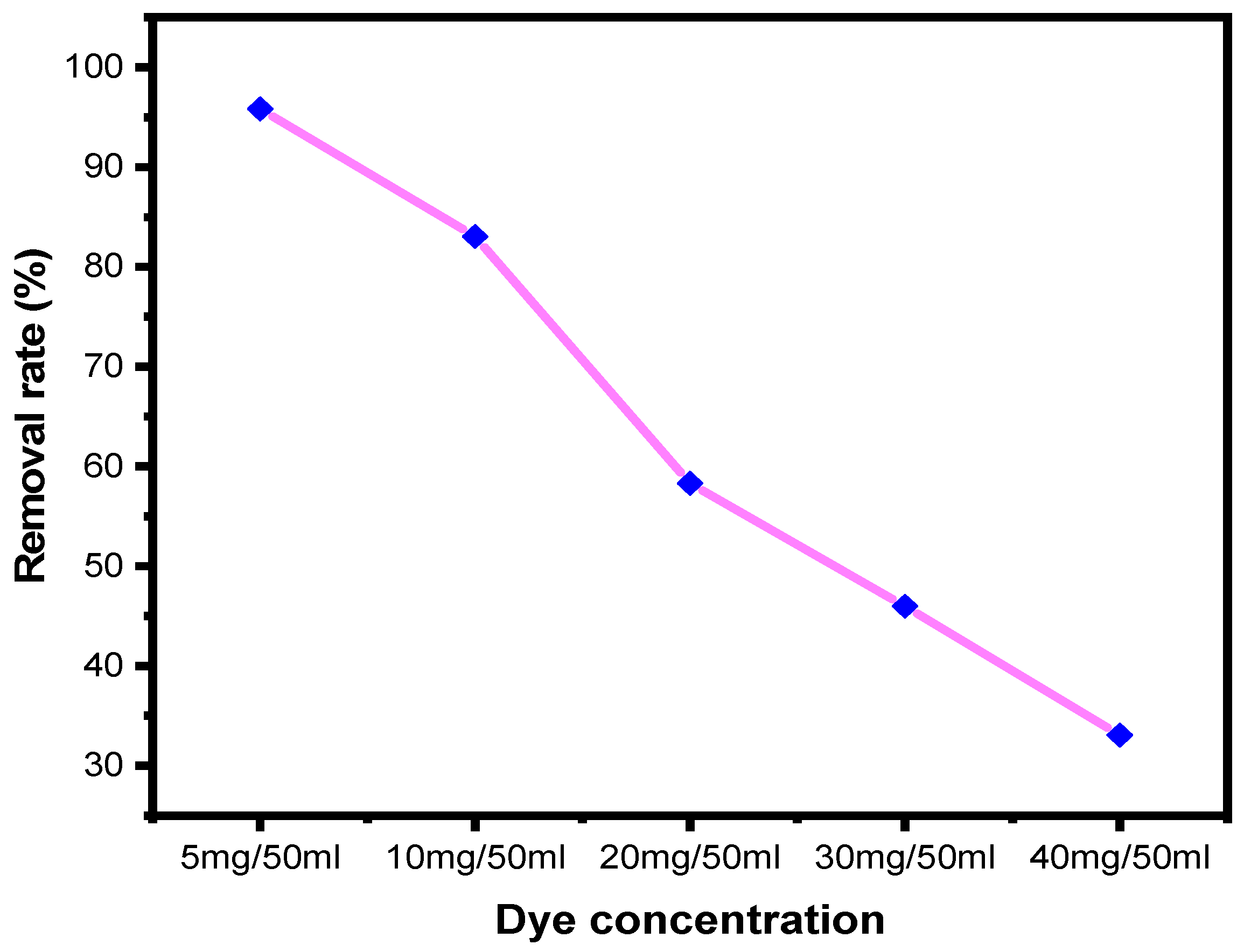

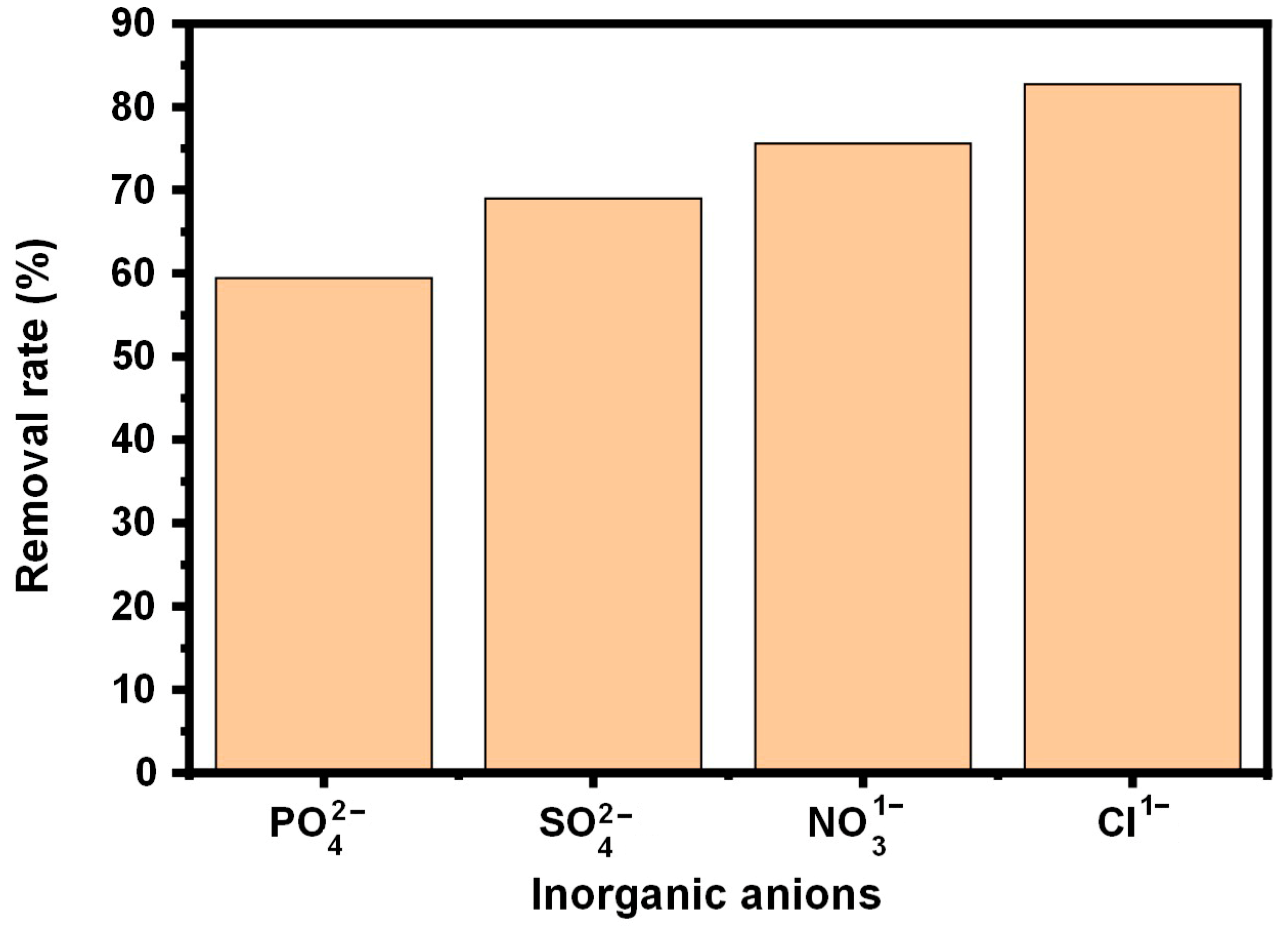

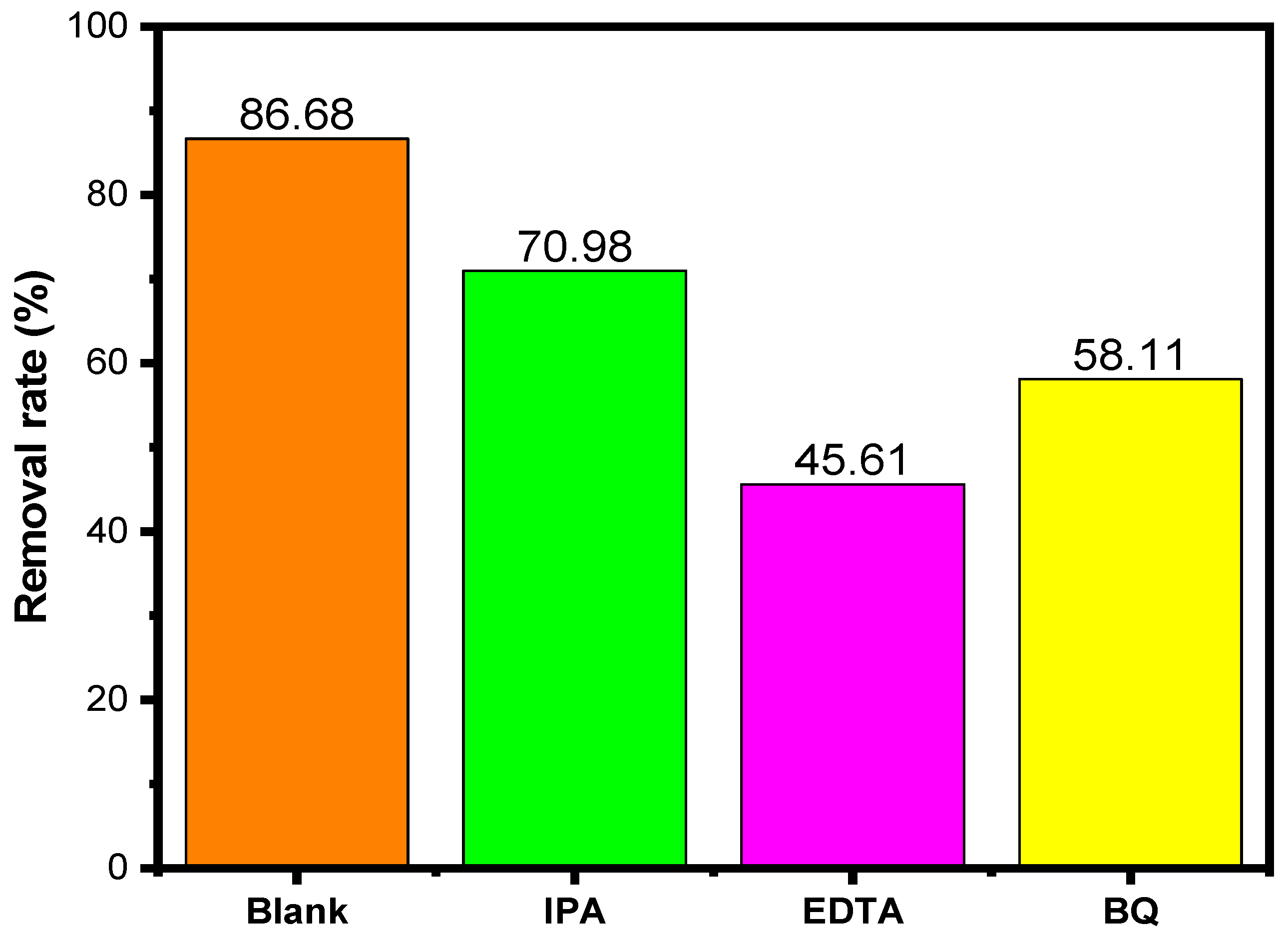
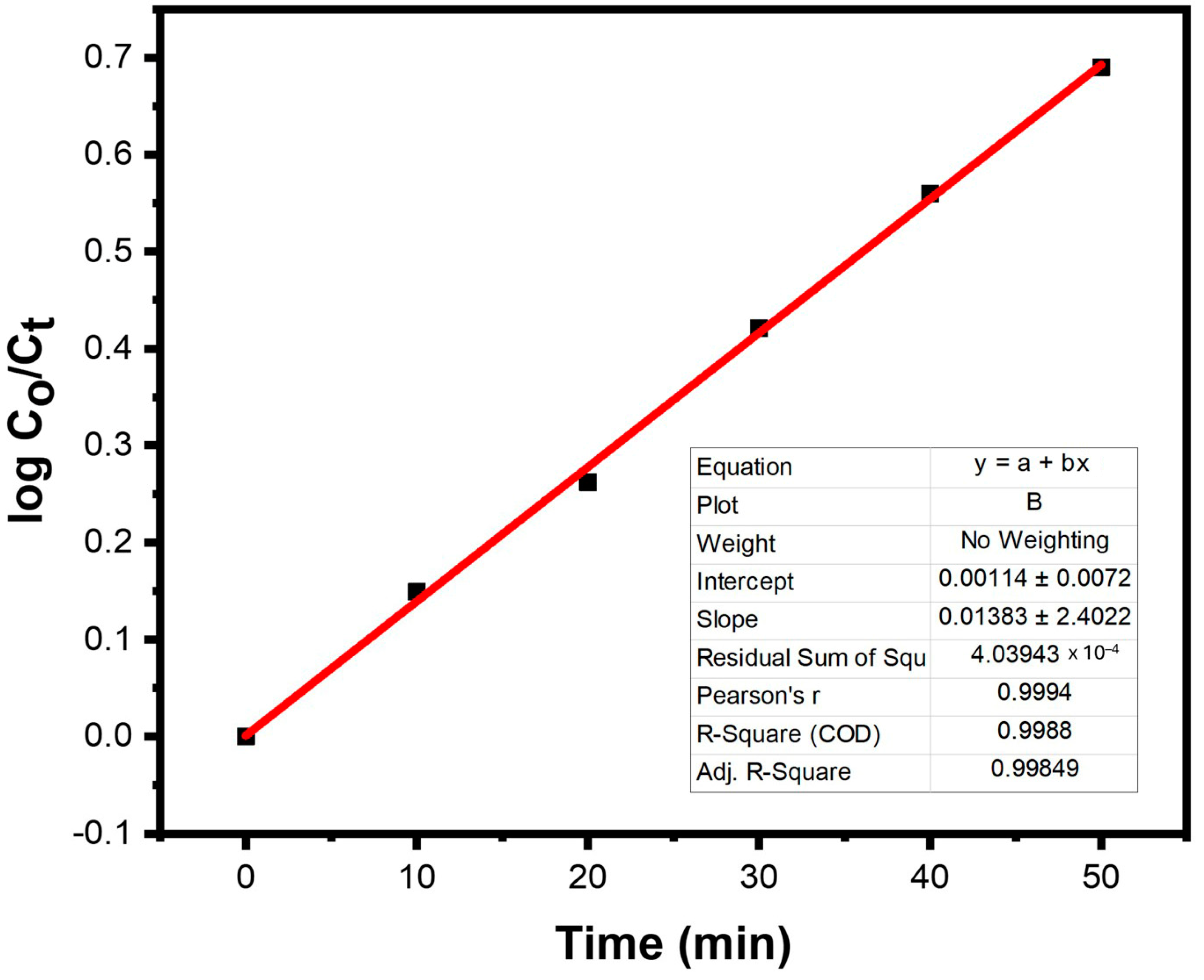

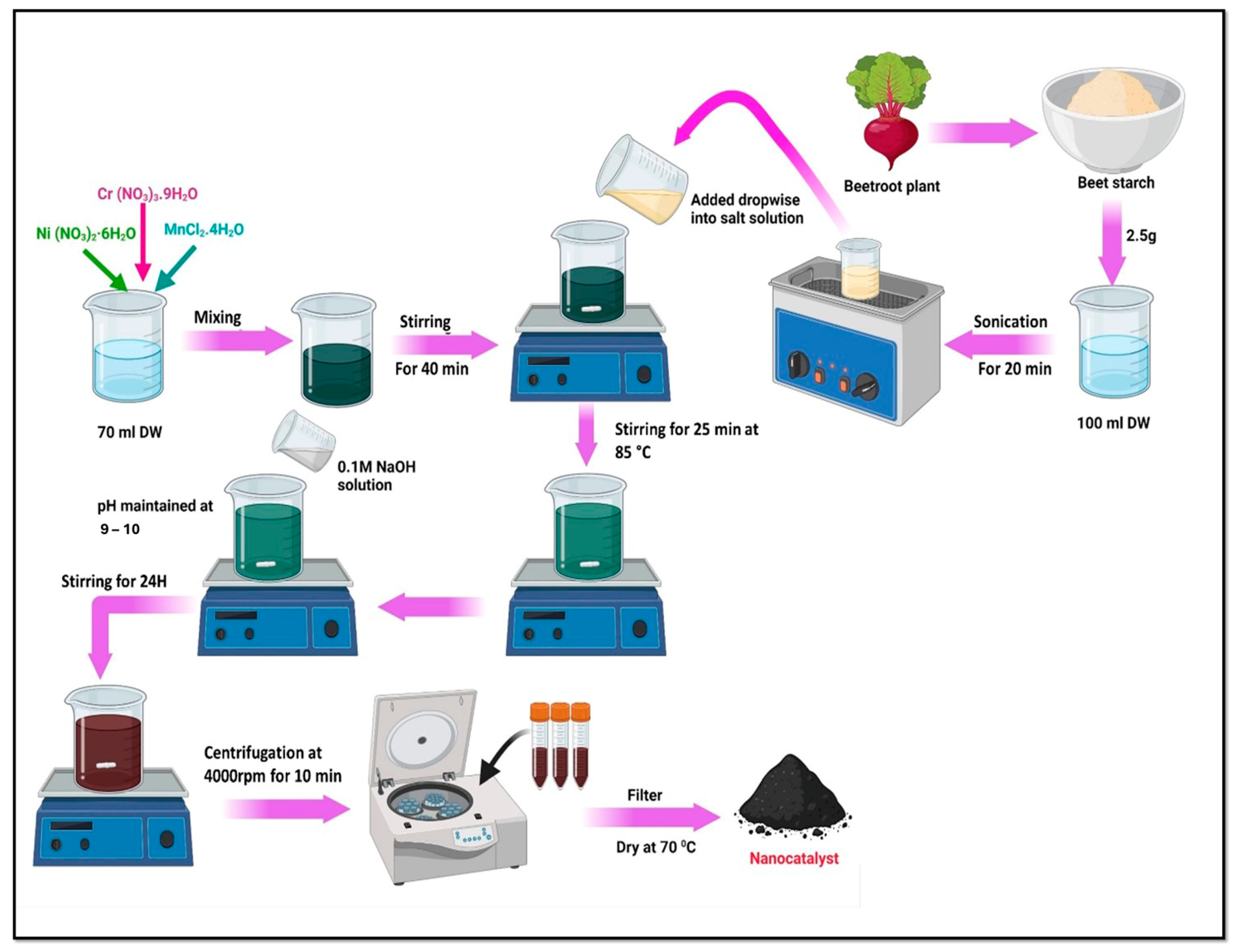
Disclaimer/Publisher’s Note: The statements, opinions and data contained in all publications are solely those of the individual author(s) and contributor(s) and not of MDPI and/or the editor(s). MDPI and/or the editor(s) disclaim responsibility for any injury to people or property resulting from any ideas, methods, instructions or products referred to in the content. |
© 2024 by the authors. Licensee MDPI, Basel, Switzerland. This article is an open access article distributed under the terms and conditions of the Creative Commons Attribution (CC BY) license (https://creativecommons.org/licenses/by/4.0/).
Share and Cite
Usman, M.; Taj, M.B.; Almasoudi, A.; Baamer, D.F.; Ali, O.M.; Khan, M.I.; Bibi, I.; Rehman, M.U.; Rasheed, R.; Raheel, A.; et al. Novel Starch-Modified NiCrMn-LDH-Based Composite for Photocatalytic Degradation of Reactive Orange 13. Catalysts 2024, 14, 449. https://doi.org/10.3390/catal14070449
Usman M, Taj MB, Almasoudi A, Baamer DF, Ali OM, Khan MI, Bibi I, Rehman MU, Rasheed R, Raheel A, et al. Novel Starch-Modified NiCrMn-LDH-Based Composite for Photocatalytic Degradation of Reactive Orange 13. Catalysts. 2024; 14(7):449. https://doi.org/10.3390/catal14070449
Chicago/Turabian StyleUsman, Muhammad, Muhammad Babar Taj, Afaf Almasoudi, Doaa F. Baamer, Omar Makram Ali, Muhammad Imran Khan, Ismat Bibi, Mobeen Ur Rehman, Rabia Rasheed, Ahmad Raheel, and et al. 2024. "Novel Starch-Modified NiCrMn-LDH-Based Composite for Photocatalytic Degradation of Reactive Orange 13" Catalysts 14, no. 7: 449. https://doi.org/10.3390/catal14070449
APA StyleUsman, M., Taj, M. B., Almasoudi, A., Baamer, D. F., Ali, O. M., Khan, M. I., Bibi, I., Rehman, M. U., Rasheed, R., Raheel, A., Lashari, M. H., Shanableh, A., & Fernandez-Garcia, J. (2024). Novel Starch-Modified NiCrMn-LDH-Based Composite for Photocatalytic Degradation of Reactive Orange 13. Catalysts, 14(7), 449. https://doi.org/10.3390/catal14070449








